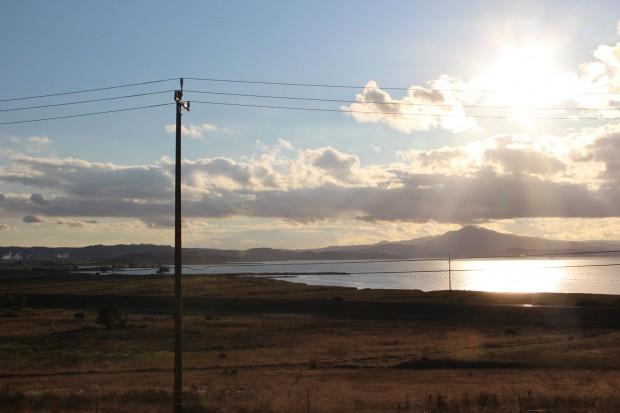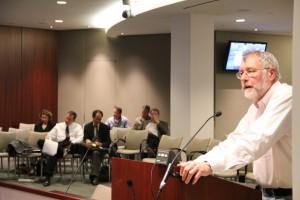North-shore zoning dispute hits crux at Planning Commission hearing

Richmond's north shore will either stay an industrial area or be re-zoned as open space when the city's General Plan is finalized in the near future.
By: Stacey Kennelly | October 7, 2011 – 3:27 pm
General Plan Quick-Facts
- The process of updating the General Plan started in 2005 in conjunction with the city's centennial celebration.
- The community visioning process involved more than 1,000 community members, including advocacy groups, public agencies and industry representatives.
- The plan emphasizes the reduction of vehicles on Richmond's roads and other efforts to limit climate-change and pollution, whereas the 1994 General Plan focused on suburban growth.
- The draft Environmental Impact Report was created earlier this year, and its final version was released with the fourth and final draft of the General Plan on Aug. 15.
Richmond residents, business owners and conservationists showed up in droves at the City Council chambers Thursday night to give the Planning Commission an earful regarding the fourth draft of the city’s major planning document and its accompanying final environmental analysis.
In all, 59 speaker cards were submitted, and most residents expressed concerns about air quality, job growth, transportation, development and especially land use.
“You can imagine that in such a city there is going to be quite a bit of debate,” said Planning and Building Services Director Richard Mitchell, referring to Richmond residents’ varying socioeconomic statuses, and the city’s blend of suburban, urban and rural lands. “Some compromise is going to be necessary in a city as diverse as this one is.”
Concerns over land use centered on Richmond’s north shore, specifically a stretch of coastline located west of Parchester Village and between San Pablo Bay and Richmond Parkway that will change from an industrial-zone designation to open space if the plan is passed as is. The debate over how to zone the space – dubbed by planners “Northshore Change Area 12” – is nothing new, but it has been heating up since earlier this year when the third draft of the General Plan was released and property owners and conservationists saw the proposed zoning change on paper.
The open-space designation is favored by environmentalists and many residents, who want to restore wildlife habitat and limit development in the area, as well as see the area become part of the larger San Francisco Bay Trail. But the idea isn’t sitting well with some residents and the four private parties who own portions of the land, who would be limited to developing it for recreational purposes, said Assistant Planner Hector Rojas. The property owners include Joe and Heidi Shekou, the Richmond Development Company, Don and Lonne Carr and Murray Parkway Partners, LLP.
“Property owners disagree,” Rojas said prior to the meeting. “They feel they could potentially lose a lot of their property value because of the more limited range of uses that are allowed under the proposed General Plan.”
Individuals on all sides of the issue spoke during the public hearing.
In general, property owners and their representatives discouraged the commission from making the zoning change, saying that it would prevent business growth and job creation in the area. Others emphasized the importance of keeping the space marketable to Silicon-Valley-type companies that might want to move in.
Some developers presented plans for projects in the area west of Goodwick Avenue that would be barred if the zoning changes occur, including Mark Lindquist, who displayed plans to develop a Salvation Army center and architect Todd Jersey, who discussed his plans to build an “artisan collaborative housing” project.
“Down-sizing or making open space would prevent jobs,” Lindquist said, noting that the Salvation Army project would bring an estimated 300 jobs to the area, and that open space would be left along the shoreline.
But conservationists don’t buy that argument, since the industrial-zoned land has sat mostly undeveloped since the city passed its last General Plan in 1994, said Mack Casterman, a conservation analyst with the East Bay chapter of the Native Plant Society, one of a few nonprofits rallying for the open-space designation. (The San Francisco Bay chapter of the Sierra Club and Citizens for East Bay Shore Parks are two other major players in the push for open space.)

Norman La Force, chair of the local chapter of the Sierra Club, makes his plea to the Planning Commission to designate a portion of the north shore as open space.
“The land owners who are bringing this debate up have had this land for a long time now, and they have not developed it,” he said after the meeting. “So that casts some doubt.”
He said the land could be better used for education, recreation and habitat restoration. He also emphasized that the land should be left undeveloped to create a buffer zone that allows for impending rising sea levels, a concern that was shared by several individuals who spoke at the mic.
“Our considerations are natural communities and natural prairies,” Casterman said. “And also a main consideration is to plan for climate change … to give those natural communities some room to migrate.”
Residents and other bystanders to the debate seemed split on the issue. Some said keeping the area as industrial space would create jobs at the expense or shorelines, while others favored the potential of economic growth near their homes.
“We sit out there isolated; it would be nice to have industry,” said Goretha Johnson, a lifelong resident of Parchester Village. “I would love to ride a bike to my job.”
Other residents encouraged the commission to designate the area open space and focus its efforts on rebuilding previously developed areas—a concept called “infilling.”
“Leave what’s already here and develop what’s blighted,” said Richmond resident Shirley Boddie.
The crowd was sparse by the time the speaker cards finally ran out near 10 p.m.
The Planning Commission will reconvene Oct. 20 to discuss its final recommendations for the General Plan and the Final Environmental Impact Report, and the north-shore issue is just one of several issues they’ll be required to decide on.
After that, the documents will head to the City Council for final approval. If the council approves them, the six-year-long process of updating the plan will come to an end. If it doesn’t, the documents will return to the Planning Commission for further revision.
Connect with Richmond Confidential on Facebook, or follow us on Twitter.

